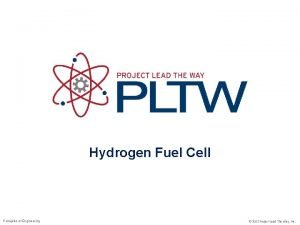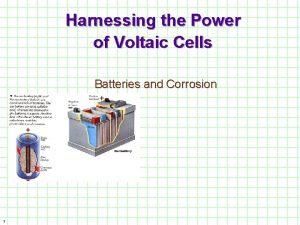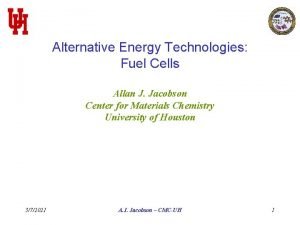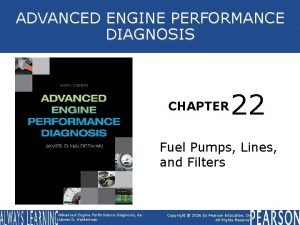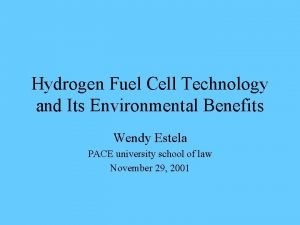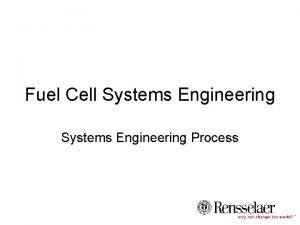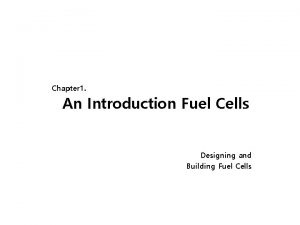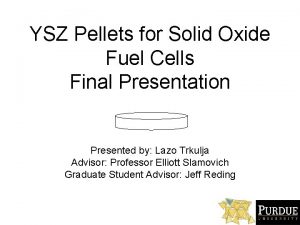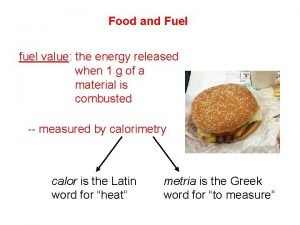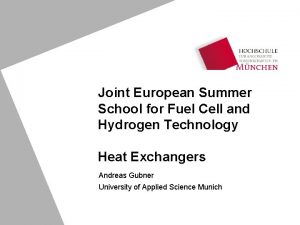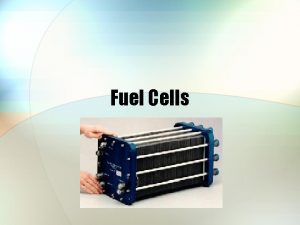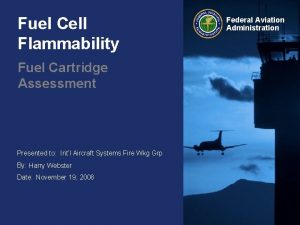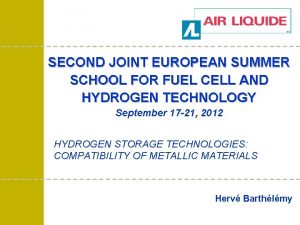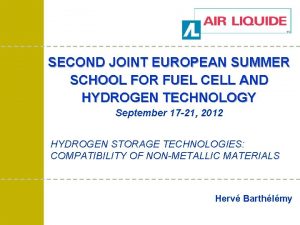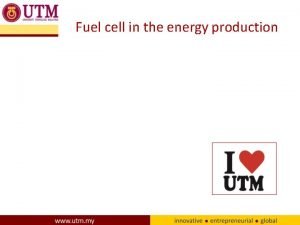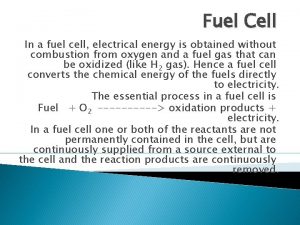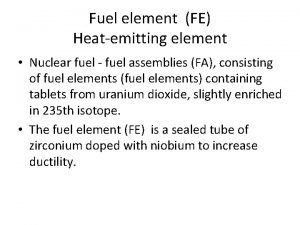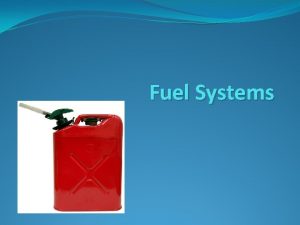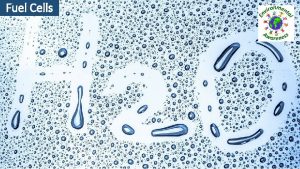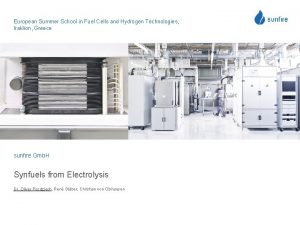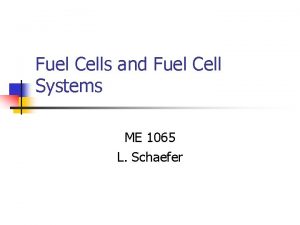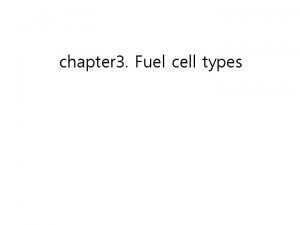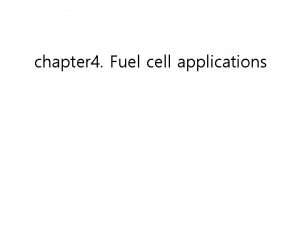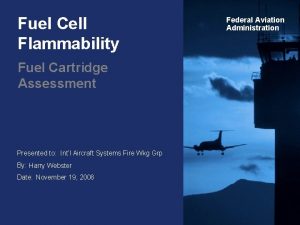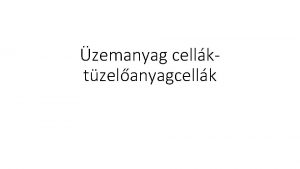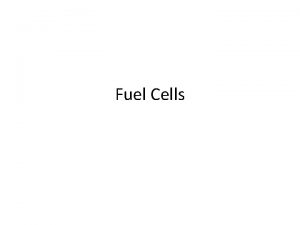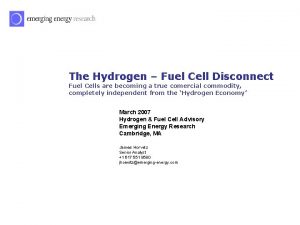Joint European Summer School for Fuel Cell and



















































- Slides: 51

Joint European Summer School for Fuel Cell and Hydrogen Technology 1 D SOFC Modeling Andreas Gubner University of Applied Science Munich

Outline § Introduction - Goals of Fuel Cell Modeling - Challenges and Scopes - Common SOFC Modeling Fundamentals § 1 D Modeling - I, V-Curve Simulation - Experimental Validation § 1 D Behavior Model - Including Temperature Distribution - Transient 1 D Modeling §Application to Dynamic Systems Modeling - Plug-In SOFC Model for Dynamic Systems Modeling 1 D Modeling Hier. SOFC wird der Titel der Präsentation wiederholt (Ansicht >Folienmaster) andreas. gubner@hm. edu 05. 06. 2021 2

Introduction: Goals of fuel cell modeling • scientific interests • understanding of the physical-chemical phenomena governing fuel cell behavior • temperature and concentration distributions (heat & mass transfer • electrochemical effects, degradation • economic interests • cost and development time reduction by using simulations as „virtual experiments“ • derivation of engineering guidelines, less „trial and error“ • system- and application design • trouble shooting 1 D Modeling Hier. SOFC wird der Titel der Präsentation wiederholt (Ansicht >Folienmaster) andreas. gubner@hm. edu 05. 06. 2021 3

Challenges • The processes governing fuel cell behavior take place at different length scales: • electrochemical kinetics and diffusion: µm to mm • flow distributions and stack temperature profiles: cm to m • systems performance: m • Mathematical model is a set of equations to be organized in a grid for resolving the spatial location of occurrence. • very fine resolution needed to capture the µm scale • which is way too fine for the m scale ] not feasable, so individual models for the • Stack: 10 x 10 = 1000 nodes for a 10 cm baseline stack at a different length scales (scopes) are resolution 1 cm needed. • same stack has 1· 105 x 1· 105 = 1· 1015 nodes at a resolution of 1 µm !! 1 D Modeling Hier. SOFC wird der Titel der Präsentation wiederholt (Ansicht >Folienmaster) andreas. gubner@hm. edu 05. 06. 2021 4

Scopes of fuel cell modeling • Subcell level • Membrane Electrode Assembly, detailed electrochemical and chemical phenomena at triple phase boundary and in the different phases • Cell level • Flow distribution, Gas supply from the manifold into the various gas channels of a cell plane as function of fuel utilization • Performance evaluation using isothermal single cells • Temperature and concentration profiles • Concept of Operation: • Operating point • Start-up, shut-down, load changes 1 D Modeling Hier. SOFC wird der Titel der Präsentation wiederholt (Ansicht >Folienmaster) andreas. gubner@hm. edu 05. 06. 2021 5

Common SOFC Modeling Fundamentals 1 D Modeling Hier. SOFC wird der Titel der Präsentation wiederholt (Ansicht >Folienmaster) andreas. gubner@hm. edu 05. 06. 2021 6

1 D Modeling § One spatial coordinate, normally the gas channel length § Massive mathematical and numerical simplification § Very flexible, suitable for systems modeling, beats any 0 D model (no spatial coordinate) § Scope classification: Systems modeling 1 D Modeling Hier. SOFC wird der Titel der Präsentation wiederholt (Ansicht >Folienmaster) andreas. gubner@hm. edu 05. 06. 2021 7

Local character of the electrochemical conversion Sketch illustrating the local mole number balance (example for a co-flow configuration) The H 2 mole flow rate in mol/s decreases continuously due to the local electric current d. I = i w dx = i d(w x) = i d. A (1) x = gas flow direction 1 D Modeling Hier. SOFC wird der Titel der Präsentation wiederholt (Ansicht >Folienmaster) andreas. gubner@hm. edu (2) 05. 06. 2021 8

Mole Fraction and Current Dependency of the Nernst Voltage: Faraday‘s Law: From the mole number balance and Faraday‘s Law it is found for the mole fractions xi: Handy reference quantities: Cathode (example for co-flow): 1 D Modeling Hier. SOFC wird der Titel der Präsentation wiederholt (Ansicht >Folienmaster) andreas. gubner@hm. edu 05. 06. 2021 9

Discussion of Basic IV-Behavior § It follows from the mathematical appearance (logarithmic dependency on the composition) of the equation for Nernst voltage that it is very sensitive toward composition changes at § a) around 0 % H 2 O and § b) around 100% H 2 O. § It is least sensitive at 50 % H 2 and 50 % H 2 O 1 D Modeling Hier. SOFC wird der Titel der Präsentation wiederholt (Ansicht >Folienmaster) andreas. gubner@hm. edu 05. 06. 2021 10

ODE system for the hydrogen conversion ODE for the electric current I in A: (1) Assumption of constant cell voltage: (2) Boundary Values: (3) 1 D Modeling Hier. SOFC wird der Titel der Präsentation wiederholt (Ansicht >Folienmaster) andreas. gubner@hm. edu 05. 06. 2021 11

Solution of the ODE system 1 D Modeling Hier. SOFC wird der Titel der Präsentation wiederholt (Ansicht >Folienmaster) 12/XY

Calculation of an I-V curve • The I-V curve of the SOFC can now be constructed pointwise by solving the ODE-System (1) to (3) for Vcell for different overall currents I(Acell) = Icell. • Due to the nonlinear Nernst voltage, a numerical solution is needed, ideally by using an ODE solver for boundary value problems for nonlinear systems of 1 st order ODEs. • In this particular case, a (simpler) initial value solver with a goal seeking routine wrapped around it can easily be used as well. 1 D Modeling Hier. SOFC wird der Titel der Präsentation wiederholt (Ansicht >Folienmaster) andreas. gubner@hm. edu 05. 06. 2021 13

Experimental Validation • Comparison with I-V Measurements for H 2/H 2 O mixtures conducted in November 2005 using 16 cm² laboratory cells (no stacks) • Variation of the H 2 O flow rate (mole fraction) • Variation of the cell temperature • These measurements are suited to allow validating the modeled composition dependence of the cell performance 1 D Modeling Hier. SOFC wird der Titel der Präsentation wiederholt (Ansicht >Folienmaster) andreas. gubner@hm. edu 05. 06. 2021 14

Measured Vs. Modeled I-V Curves T = 700 °C All ASR values determined by taking only one pair of (I, V) @ Imax 1 D Modeling Hier. SOFC wird der Titel der Präsentation wiederholt (Ansicht >Folienmaster) andreas. gubner@hm. edu 05. 06. 2021 15

Measured vs. modelled I-V curves T = 750 °C All ASR values determined by taking only one pair (I, V) @ Imax 1 D Modeling Hier. SOFC wird der Titel der Präsentation wiederholt (Ansicht >Folienmaster) andreas. gubner@hm. edu 05. 06. 2021 16

Measured vs. modelled I-V curves T = 800 °C All ASR values determined by taking only one pair (I, V) @ Imax 1 D Modeling Hier. SOFC wird der Titel der Präsentation wiederholt (Ansicht >Folienmaster) andreas. gubner@hm. edu 05. 06. 2021 17

Comparison between model and experiment Temperature Dependence @ x. H 2 O = 50 %: H 2: 0, 5 l/min H 2 O: 0, 5 l/min Air: 1 l/min 1 D Modeling Hier. SOFC wird der Titel der Präsentation wiederholt (Ansicht >Folienmaster) andreas. gubner@hm. edu 05. 06. 2021 18

Arrhenius plot for determining EA and ASR∞ 1 D Modeling Hier. SOFC wird der Titel der Präsentation wiederholt (Ansicht >Folienmaster) andreas. gubner@hm. edu 05. 06. 2021 19

ASR data comparison 1 D Modeling Hier. SOFC wird der Titel der Präsentation wiederholt (Ansicht >Folienmaster) andreas. gubner@hm. edu 05. 06. 2021 20

Test of VNernst(T) Comparison of measured and modelled values of the Nernst voltage • Wrong temperature dependence at 3 % and 10 % humidity was observed: • Nernst voltage should decrease and not increase: Explained by Leakage • Satisfactory agreement at 25 % and 50 % humidity observed 1 D Modeling Hier. SOFC wird der Titel der Präsentation wiederholt (Ansicht >Folienmaster) andreas. gubner@hm. edu 05. 06. 2021 21

Modelling Results § The experimentally determined function ASR(T) was used for simulating: § I-V-curves at different fuel utilizations and inlet humidities § An endurance test – V(t) at constant I was calculated based on assuming linear ASR increase over time 1 D Modeling Hier. SOFC wird der Titel der Präsentation wiederholt (Ansicht >Folienmaster) andreas. gubner@hm. edu 05. 06. 2021 22

Modeled I-V Curves Different UF @ 3 % inlet humidity ASR from slope is around 1. 2 A/cm²: UF in ASR in % Ω cm² 14 0. 192 28 0. 201 56 0. 221 80 0. 264 1 D Modeling Hier. SOFC wird der Titel der Präsentation wiederholt (Ansicht >Folienmaster) andreas. gubner@hm. edu 05. 06. 2021 23

Local Current Density Distribution 3 Vol. -% H 2 O UF = 14 and 80 % 1 D Modeling Hier. SOFC wird der Titel der Präsentation wiederholt (Ansicht >Folienmaster) andreas. gubner@hm. edu 05. 06. 2021 24

Modeled I-V Curves Different UF @ 50 % inlet humidity ASR from slope around 1. 2 A/cm²: UF in ASR in % Ω cm² 14 0. 171 28 0. 178 56 0. 198 80 0. 238 1 D Modeling Hier. SOFC wird der Titel der Präsentation wiederholt (Ansicht >Folienmaster) andreas. gubner@hm. edu 05. 06. 2021 25

Local Current Density Distribution 50 Vol. -% H 2 O UF = 14 and 80 % 1 D Modeling Hier. SOFC wird der Titel der Präsentation wiederholt (Ansicht >Folienmaster) andreas. gubner@hm. edu 05. 06. 2021 26

Conclusions § It is possible to describe the SOFC performance by an „Ohmic“ ASR between 700 °C and 800 °C § Validated by SOFC cell measurements – temperatures from 700 °C to 800 °C – humidities from 3 Vol. -% H 2 O to 50 Vol. -% H 2 O § Using the presented computer model, no I-V curve measurement is necessary to determine the ASR § When determining the ASR by taking the slope of I-V curves, they should be measured at UF < 14 % and around 50 Vol-% H 2 O 1 D Modeling Hier. SOFC wird der Titel der Präsentation wiederholt (Ansicht >Folienmaster) andreas. gubner@hm. edu 05. 06. 2021 27

1 D Behavior Model § Extension of the isothermal model § Able to simulate 1 D temperature distribution along the gas channels § Disadvantage: must be backed by 3 D information (measurements or 3 D modeling) § Advantage: low CPU-requirements - rapidly executing (seconds rather than hours or even days) § Can be cast into a flexible piece of core code (*. dll) that can be used stand alone for extensive parameter studies or in dynamic systems modeling 1 D Modeling Hier. SOFC wird der Titel der Präsentation wiederholt (Ansicht >Folienmaster) andreas. gubner@hm. edu 05. 06. 2021 28

Model Assumptions and Input Values § 1 dimensional simplification of the stack‘s 3 D structure - One spatial coordinate: the x-direction parallel to the gas channels c Limited to co- and counterflow SOFC design, but: c Rapid model execution § Internal CH 4 reforming: - 1 st order kinetics w/ respect to CH 4 (zero order w/ respect to H 2 O) - Watergas Shift reaction in chemical equilibrium § Electrochemical fuel conversion (oxidation): with at 1 D Modeling Hier. SOFC wird der Titel der Präsentation wiederholt (Ansicht >Folienmaster) andreas. gubner@hm. edu 05. 06. 2021 29

Model Assumptions and Input Values § Pre-reformed fuel w/ the following composition (in Vol-%): CH 4 H 2 O CO CO 2 16. 6 39. 7 1. 0 8. 2 H 2 N 2 33. 3 1. 2 § Inlet temperatures in °C: and § Standard Juelich Design w/ JS 3 interconnector plates based on a 20 x 20 cm² MEA § Isobaric operation (pressure drop neglected) at an absolute pressure of 0. 1 MPa 1 D Modeling Hier. SOFC wird der Titel der Präsentation wiederholt (Ansicht >Folienmaster) andreas. gubner@hm. edu 05. 06. 2021 30

Model Assumptions and Input Values § Overall energy balance: adiabatic boundary conditions domain boundary Anode Cathode 1 D Modeling Hier. SOFC wird der Titel der Präsentation wiederholt (Ansicht >Folienmaster) andreas. gubner@hm. edu 05. 06. 2021 31

Simulations § Base Case c The total fuel flow rate is derived from this average current density and this fuel utilization. The air flow rate is adjusted so that the local maximum temperature of the bipolar plate is limited to below 800 °C. The air flow rate is expressed in terms of the air excess number c This results in 1 D Modeling Hier. SOFC wird der Titel der Präsentation wiederholt (Ansicht >Folienmaster) andreas. gubner@hm. edu 05. 06. 2021 32

Simulation of the Base Case Maximum Temperature controlled by Air Excess Number 1 D Modeling Hier. SOFC wird der Titel der Präsentation wiederholt (Ansicht >Folienmaster) andreas. gubner@hm. edu with 05. 06. 2021 33

Case Definition Case 1 § Constant Fuel and Air Flow § The Fuel Utilization is varied between 0 and 80 % Case 2 § Constant Fuel Utilization § The Fuel Utilization is held constant at 80 % 1 D Modeling Hier. SOFC wird der Titel der Präsentation wiederholt (Ansicht >Folienmaster) andreas. gubner@hm. edu 05. 06. 2021 34

Case 1: Idle Operation • This is a new stationary case reached after a power shut down (to nearly 0) at constant fuel and air flow. • There is almost no electrochemical conversion but internal reforming is still taking place. • The reforming process is driven by the entering, now comparatively warm air. 1 D Modeling Hier. SOFC wird der Titel der Präsentation wiederholt (Ansicht >Folienmaster) andreas. gubner@hm. edu 05. 06. 2021 35

Case 1: Relation between i, V-Curve and Maximum Temperature • The i, V-curve (blue) shows a nonlinear behavior although the low field approximation is used: • This is mainly due to non-isothermal behavior (red curve on the right) • UF is a linear function if the average current density i due to constant gas flow. 1 D Modeling Hier. SOFC wird der Titel der Präsentation wiederholt (Ansicht >Folienmaster) andreas. gubner@hm. edu 05. 06. 2021 36

Case 1: Transient Load Change Example: 0. 35 A cm-2 to 0. 55 A cm-2 • The current density is increased instantly while both the fuel and the air flow are held constant. • It takes here approx. 30 min to re-establish the base coming from a part load operating point. • Undershooting cell voltage: Risk of Ni. O formation? 1 D Modeling Hier. SOFC wird der Titel der Präsentation wiederholt (Ansicht >Folienmaster) andreas. gubner@hm. edu 05. 06. 2021 37

Case 1: Transient Load Change Example: 0. 55 Acm-2 to 0. 007 Acm-2 • Transient Load Change from the base case to the idle state after in instant power shut down (reduction). • The cell voltage jumps up and then drifts to its new stationary state at a higher value • This is because the Nernst potential is higher at lower temperatures. 1 D Modeling Hier. SOFC wird der Titel der Präsentation wiederholt (Ansicht >Folienmaster) andreas. gubner@hm. edu 05. 06. 2021 38

Case 2: Idle Operation • In case 2, now UF (and as in case 1) are held constant while both the fuel and the air flow are varied: • at this idle point, there is only a small gas flow rate through the SOFC • There is both internal reforming and electrochemical H 2 conversion with UF = 80 % 1 D Modeling Hier. SOFC wird der Titel der Präsentation wiederholt (Ansicht >Folienmaster) andreas. gubner@hm. edu 05. 06. 2021 39

Case 2: Relation between V-i Curve and Maximum Temperature • The V-i curve (blue) seems less nonlinear as in case 1: • The initially rapidly increasing SOFC temperature (red curve on the right) levels off the sharp decline as seen in case 1 • The thermal efficiency decreases with increasing current density because UF is constant and Vcell is decreasing 1 D Modeling Hier. SOFC wird der Titel der Präsentation wiederholt (Ansicht >Folienmaster) andreas. gubner@hm. edu 05. 06. 2021 40

Case 2: Transient Load Change Example: 0. 05 A cm-2 to 0. 55 A cm-2 • The current density is increased instantly while UF (and ) were held constant, so both the fuel and the air flow were increased. • It takes here (as in case 1) approx. 30 min to re-establish the base coming from a part load operating point. • Undershooting cell voltage not as serious as in case 1 1 D Modeling Hier. SOFC wird der Titel der Präsentation wiederholt (Ansicht >Folienmaster) andreas. gubner@hm. edu 05. 06. 2021 41

Case 2: Transient Load Change Example: 0. 55 Acm-2 to 0. 007 Acm-2 • After a power shut down to almost 0 W, there is also a corresponding reduction of the gas flow rates • This causes an initial heat distribution into both Bi. P-tips due to stored heat • However, the SOFC cannot maintain ist temperature level and starts drifting into the idle state over a very long time. • After the initial jump, Vcell decreases first due to a still high ASR and then increases due to Nernst. 1 D Modeling Hier. SOFC wird der Titel der Präsentation wiederholt (Ansicht >Folienmaster) andreas. gubner@hm. edu 05. 06. 2021 42

Conclusion of Transient Load Changes: Comparison of Case 1 & 2 Case 1: Constant fuel flow rate Case 2: Constant fuel utilization • Current was stepped up in two intervals in both cases • Bi. P Temperature maximum sweeps through Bi. P • Bi. P Temperature maximum stays more or less in one place 1 D Modeling Hier. SOFC wird der Titel der Präsentation wiederholt (Ansicht >Folienmaster) andreas. gubner@hm. edu 05. 06. 2021 43

Conclusions & Outlook § All transient load changes show an instant voltage jump as a result of an instant current jump (confirming earlier findings by E. Achenbach). § After the current jump, the voltage may over- or undershoot at first but then it drifts toward a new stable value as a new thermal steady state balance is established over time. § Voltage undershooting, which is seen after a load increase, is more critical because a critical value below which anode oxidation may occur may be passed temporarily. § Hence stepping up the current is more critical to the SOFC than relaxing the current. § Stepping up the current at constant UF seems more stable causing less voltage undershooting § However, transient load changes at constant flow rates tend to reach a new steady state more rapidly. § Temperature maximum is easier to measure and control in case of constant UF because it stays in a narrow range of the Bi. P length § Future work should also consider the development of suitable control strategies. 1 D Modeling Hier. SOFC wird der Titel der Präsentation wiederholt (Ansicht >Folienmaster) andreas. gubner@hm. edu 05. 06. 2021 44

Application to Systems Modeling § Core code (without user interface) was packaged as a *. dll which could be used as a component in a Dynamic Systems Model in MATLAB/SIMULINK 1 D Modeling Hier. SOFC wird der Titel der Präsentation wiederholt (Ansicht >Folienmaster) andreas. gubner@hm. edu 05. 06. 2021 45

20 k. W Demonstration Plant: SYSTEM DESIGN & MODELLING APPROACH Dynamic Reformer, Burner, Evaporator and Heat Exchanger Models Cascade of continuous stirred tank reactors (set of ODEs) Dynamic SOFC Model Existing 1 D-plug-flow reactor model (PDEs) 1 D Modeling Hier. SOFC wird der Titel der Präsentation wiederholt (Ansicht >Folienmaster) andreas. gubner@hm. edu 05. 06. 2021 46

CO-Simulation with Simulink: Test Environment 1 D Modeling Hier. SOFC wird der Titel der Präsentation wiederholt (Ansicht >Folienmaster) andreas. gubner@hm. edu 05. 06. 2021 47

CO-Simulation with Simulink: Fuel Cell System 1 D Modeling Hier. SOFC wird der Titel der Präsentation wiederholt (Ansicht >Folienmaster) andreas. gubner@hm. edu 05. 06. 2021 48

Model Validation § All system components were extensively tested for validation of the models Burner model validation: Experimental results and simulated data gas streams at burner inlet Test facility at FZJ 1 D Modeling Hier. SOFC wird der Titel der Präsentation wiederholt (Ansicht >Folienmaster) andreas. gubner@hm. edu 49 05. 06. 2021

Simulation of Start-Up and Nominal Load air inlet: steady-state @ SOFC profile cooling effect due to temperature nominal load (20 lower off-gas temperature k. W) 600 °C initial condition from heat-up simulation Conditions at nominal load i = 350 m. A/cm 2 U = 745 m. V Pel = 20. 7 k. W hu = 70 % TSOFC < 750 °C Simulation results • Design point from stationary calculations confirmed fuel inlet: • Start-up time < 1 h cooling effect duepossible to internal reforming 1 D Modeling Hier. SOFC wird der Titel der Präsentation wiederholt (Ansicht >Folienmaster) andreas. gubner@hm. edu 05. 06. 2021 50

Summary § Results of fundamental research implemented in the SOFC Models. § 1 D model validated with (1) experiments and (2) 3 D CFD simulations. § 1 D behavior model used as a tool for parameter studies. § Co-simulation of 1 D model with system simulation software (e. g. : Simulink) enables to design SOFC systems. – e. g. optimization of system start-up, load change, controls. 1 D Modeling Hier. SOFC wird der Titel der Präsentation wiederholt (Ansicht >Folienmaster) andreas. gubner@hm. edu 05. 06. 2021 51
 Torches
Torches What is fuel cell in chemistry
What is fuel cell in chemistry Fuel cell apollo
Fuel cell apollo Fuel cell apollo
Fuel cell apollo Roller cell fuel pump
Roller cell fuel pump Hydrogen cycle
Hydrogen cycle Fuel cell uses
Fuel cell uses Fuel cell system
Fuel cell system Molten carbonate fuel cell
Molten carbonate fuel cell Solid oxide fuel cell
Solid oxide fuel cell Fuel value of food
Fuel value of food Fuel cell heat exchanger
Fuel cell heat exchanger Hydrogen energy advantages and disadvantages
Hydrogen energy advantages and disadvantages Fuel cell cartridge
Fuel cell cartridge Lodi summer school
Lodi summer school Crescenta valley high school graduation 2021
Crescenta valley high school graduation 2021 Assignment in spanish
Assignment in spanish What is a semi permanent joining application
What is a semi permanent joining application Plane joint
Plane joint Spool joint lamb
Spool joint lamb Costotransverse joint
Costotransverse joint Joint bank account in joint venture
Joint bank account in joint venture Break joint vs spool joint
Break joint vs spool joint Advantages and disadvantages of diaphragm cell process
Advantages and disadvantages of diaphragm cell process Prokaryotic
Prokaryotic Venn diagram plant and animal cells
Venn diagram plant and animal cells Vacuole function
Vacuole function Cytosol plant cell
Cytosol plant cell Lead acid battery primary or secondary
Lead acid battery primary or secondary Difference between plant and animal cell
Difference between plant and animal cell Cell cycle and cell division
Cell cycle and cell division Prokaryotic cell and eukaryotic cell
Prokaryotic cell and eukaryotic cell The scientist mathias schleiden studied _______ in ______.
The scientist mathias schleiden studied _______ in ______. Idealized plant cell
Idealized plant cell Walker cell and hadley cell
Walker cell and hadley cell Cell cycle and cell division
Cell cycle and cell division Plant and animal cell venn diagram
Plant and animal cell venn diagram Phases of cell cycle
Phases of cell cycle Electrolytic cell picture
Electrolytic cell picture Flexible covering of an animal cell
Flexible covering of an animal cell Iso 22301 utbildning
Iso 22301 utbildning Novell typiska drag
Novell typiska drag Tack för att ni lyssnade bild
Tack för att ni lyssnade bild Vad står k.r.å.k.a.n för
Vad står k.r.å.k.a.n för Shingelfrisyren
Shingelfrisyren En lathund för arbete med kontinuitetshantering
En lathund för arbete med kontinuitetshantering Kassaregister ideell förening
Kassaregister ideell förening Personlig tidbok fylla i
Personlig tidbok fylla i A gastrica
A gastrica Vad är densitet
Vad är densitet Datorkunskap för nybörjare
Datorkunskap för nybörjare Tack för att ni lyssnade bild
Tack för att ni lyssnade bild

